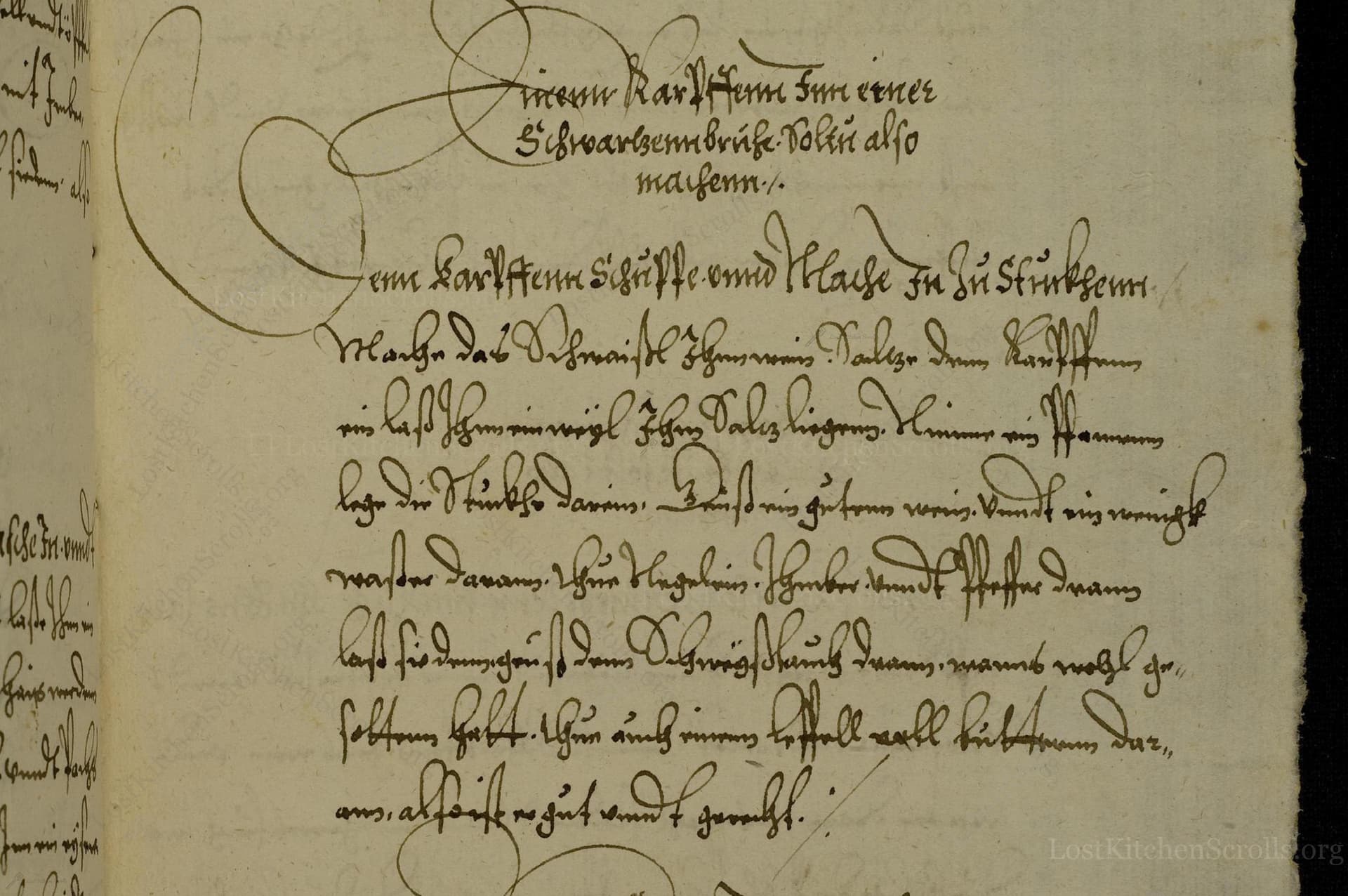Von Karbfenn Inn Einer Schwartzen Brühe Vonn Also Maissen
"Of Caraway In A Black Broth Made Thus"
From the treasured pages of Kochbuch
Unknown Author

Von Karbfenn Inn Einer Schwartzen Brühe Vonn Also Maissen
"Neme Karbfenn Sÿpffe vnnd klause In stückhenn Wasche das selbe nit ab sonndern lege den Karbfenn in daß man nigel schaltz darein lege. Nimm ein Pfannen lege die stückle darein. laß nit gar braun werden. vnnd nim wenig wasser darzu. Nim Ingber. Pfeffer vnnd saffran darzu laß es durchsieden. thue Oßig darein. wanns wohl gesottenn gestelt. Nim auch einenn löffell voll bählten meel darzu. also ist es recht vnnd guett gewurzt."
English Translation
"Take caraway tops and enclose them in pieces. Do not wash it off, but place the caraway in it so that one adds fresh lard. Take a pan, put the pieces in. Do not let them get completely brown, and add a little water to it. Take ginger, pepper and saffron, add them and let it boil through. Put vinegar in as well. When it is well cooked, remove it. Also take a spoonful of white flour and add it. That is how it is right and well seasoned."
Note on the Original Text
The recipe is written in Early New High German, with distinctive late medieval spelling. Words like 'Karbfenn' (for 'Karpfen', carp), 'Sÿpffe' (for 'Süpfen', pieces), and 'thue' (for 'tue', add) might look unfamiliar today. Instructions are direct, with little attention to precise timing or measurements. Such manuals assumed the cook had substantial culinary skill and understood the context of kitchen work. The language is economical, omitting basic actions like cleaning (unless specifically forbidden, as here).

Title
Kochbuch (1570)
You can also click the book image above to peruse the original tome
Writer
Unknown
Era
1570
Publisher
Unknown
Background
A flavorful journey back to the last third of the 16th century in the Oberpfalz region, this cookbook serves up a delightful menu of Renaissance-era recipes and culinary wisdom—perfect for those who wish to feast like nobles of old.
Kindly made available by
Heidelberg, Universitätsbibliothek
This recipe comes from the Oberpfalz region in what is today Bavaria, Germany, dating from the last third of the 16th century. During this time, carp was a common freshwater fish, especially in regions with abundant ponds and rivers—an important part of the local cuisine, particularly during religious fasting periods when meat from four-legged animals was forbidden. The recipe reflects the late medieval and early modern taste for highly spiced, brightly colored dishes, and for the use of sour flavors from vinegar. Black broth (schwarze Brühe) was a hallmark of festive fish dishes, lending both richness from the lard and a dramatic look from the saffron and possibly uncleaned fish.

In period kitchens, this would be prepared using an iron pan or shallow cauldron set directly over an open hearth or on embers. A wooden spatula or spoon would be used for stirring. Flour might be added using a small wooden ladle or scoop. Measuring would be by eye, handful, or spoonful, rather than by exact weights or volumes.
Prep Time
10 mins
Cook Time
30 mins
Servings
2
We've done our best to adapt this historical recipe for modern kitchens, but some details may still need refinement. We warmly welcome feedback from fellow cooks and culinary historians — your insights support the entire community!
Ingredients
- 1 lb 2 oz carp fillets or pieces (with skin, and ideally some scales)
- 2–2.6 oz lard (or substitute: rendered pork fat or unsalted butter)
- 7 fl oz water
- 1 tsp ground ginger
- 1/2 tsp ground black pepper
- 1 generous pinch saffron
- 1–2 tbsp vinegar (wine vinegar or apple cider vinegar)
- 1 tbsp wheat flour
Instructions
- Take carp fillets or pieces, keeping on the skin and some scales if possible (as the original recipe would not have encouraged thorough washing).
- Place the carp in a pan with enough lard (about 2–2.6 oz) to cover the bottom, and fry gently so the fish does not brown too much.
- Add just enough water (around 7 fl oz) to partially cover the fish.
- Season with ginger (1 tsp), ground black pepper (1/2 tsp), and saffron (a generous pinch).
- Let the fish cook through by simmering gently.
- Add vinegar (1–2 tbsp, to taste) once the fish is nearly cooked, for brightness.
- Finally, thicken the sauce with a tablespoon of wheat flour, stirring well so there are no lumps.
- Serve the dish hot, with the sauce poured over the carp pieces.
Estimated Calories
370 per serving
Cooking Estimates
You will spend about 10 minutes preparing the ingredients and about 30 minutes cooking the dish. Each serving has around 370 calories. The recipe makes 2 servings.
As noted above, we have made our best effort to translate and adapt this historical recipe for modern kitchens, taking into account ingredients nowadays, cooking techniques, measurements, and so on. However, historical recipes often contain assumptions that require interpretation.
We'd love for anyone to help improve these adaptations. Community contributions are highly welcome. If you have suggestions, corrections, or cooking tips based on your experience with this recipe, please share them below.
Join the Discussion
Rate This Recipe
Dietary Preference
Main Ingredients
Culinary Technique
Occasions

Den Bockfisch In Einer Fleisch Suppen Zu Kochen
This recipe hails from a German manuscript cookbook compiled in 1696, a time whe...

Die Grieß Nudlen Zumachen
This recipe comes from a rather mysterious manuscript cookbook, penned anonymous...

Ein Boudain
This recipe comes from an anonymous German-language manuscript cookbook from 169...

Ein Gesaltzen Citroni
This recipe, dating from 1696, comes from an extensive anonymous German cookbook...
Browse our complete collection of time-honored recipes



